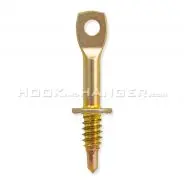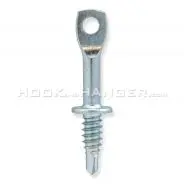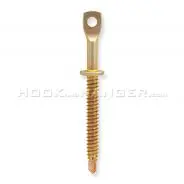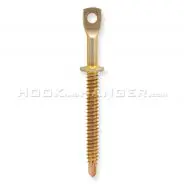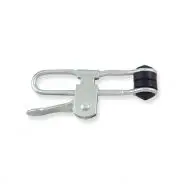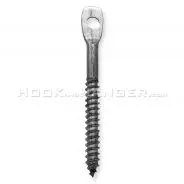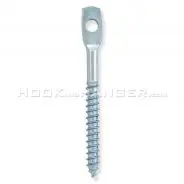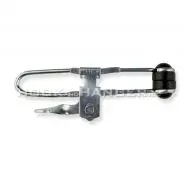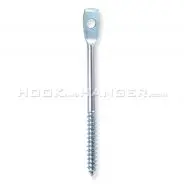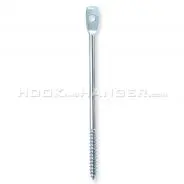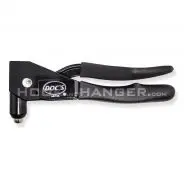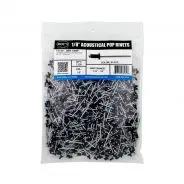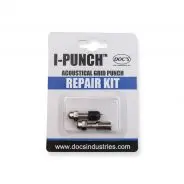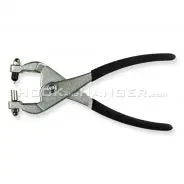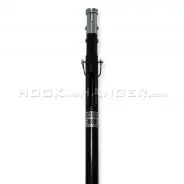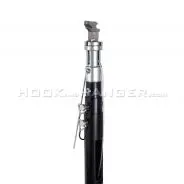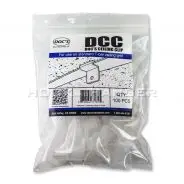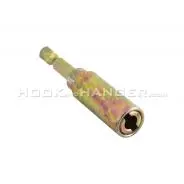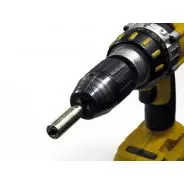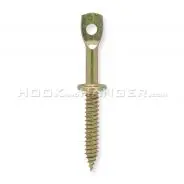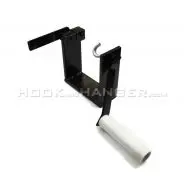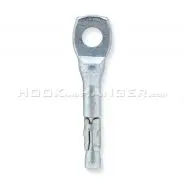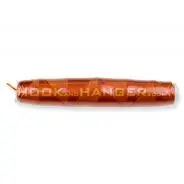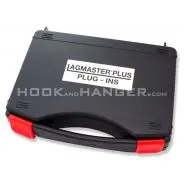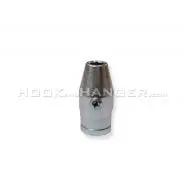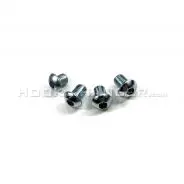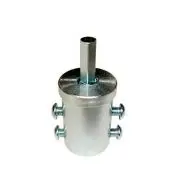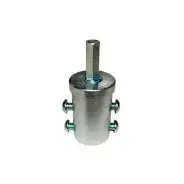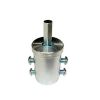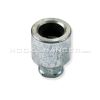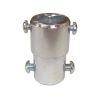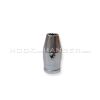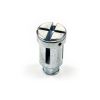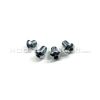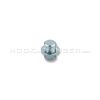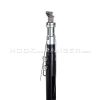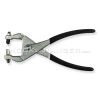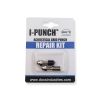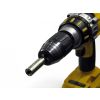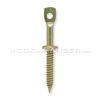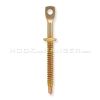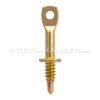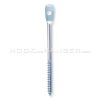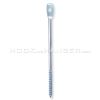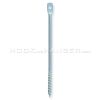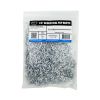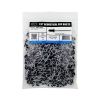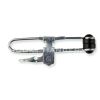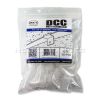
Suspended Ceiling
In commercial, industrial, and large residential spaces, ceilings do more than just conceal the underside of a roof. They serve as access points for lighting, HVAC systems, cabling, and fire suppression equipment, while also playing a role in thermal insulation, acoustic control, and interior aesthetics. Suspended ceilings (also known as drop ceilings or false ceilings) have become a widely adopted solution for managing all of these elements efficiently and cleanly.
But behind every suspended ceiling is a network of specialized tools, anchors, and support systems that must be selected, installed, and maintained correctly. Whether you're outfitting a hospital corridor or a retail showroom, choosing the right suspended ceiling components is essential for safety, durability, and ease of access.
- 2" I-Lag™ (Eye Lag Screw) 750 SDW for 16-22 Gauge Sheet Metal with Silver Zinc Plating - 1000 pcs. by Doc's Industries Inc. 750 SDW (1,000PCS)$230.40 (Pk1000)
- 3 3/4" I-Lag™ Screw - Goes Through Two Layers of Drywall then Sheet Metal by Doc's Industries Inc. 225 SDC (100PCS)$43.97 (Pk100)
- 3" I-Lag™ Screw (Eye Lag Screw) for Use in Wood - 1000 pcs. by Doc's Industries Inc. W300M (1,000PCS)$94.95 (Pk1000)
- Eye Lag Screw Drill Adapter - The I-Drill Driver by Doc's Industries Inc. I-Drill Driver (1PC)$7.14 (each)
- Eye Lag Screw Drill Adapter - The I-Drill Driver SM by Doc's Industries Inc. I-DRILL DRIVER SM (1 PC)$5.72 (each)
- LM Button Head Screws - Quantity of 4 by Doc's Industries Inc. LM 1/4-28 x 3/8 Button Head (L)$2.75
Why Suspended Ceilings Are a Practical Necessity
In many buildings, suspended ceilings aren’t just a design choice; they’re a practical necessity.
Here’s why:
1. Access to Infrastructure
Electrical cables, air ducts, pipework, and fire sprinklers are often hidden above the ceiling plane. A suspended grid allows tiles to be removed for quick access during inspections or repairs.
2. Improved Acoustics
Acoustic ceiling tiles absorb sound and reduce echo in large, busy spaces like offices, schools, and hospitals.
3. Energy Efficiency
Some ceiling tiles provide thermal insulation, reducing heating and cooling costs by limiting airflow between floors.
4. Clean Aesthetics
Tiled ceilings create a neat, finished look and are easily replaced if damaged or stained.
5. Fire Compliance
Many ceiling systems include fire-rated components that slow flame spread and comply with safety codes.
But while the benefits are clear, the installation process is often underestimated, particularly when it comes to choosing the right hardware for the ceiling type, structure, and building material.
Common Installation Challenges (and How the Right Tools Solve Them)
Installing a suspended ceiling involves more than simply hanging tiles in a grid. Below are a few of the common pain points that installers face and why having the right setup matters:
1. Working Safely at Height
Installing fasteners and hangers overhead typically requires ladders or scaffolding. This slows down the job and increases fall risk. Using telescoping extension poles (such as Lagmaster Plus) simplifies overhead drilling and anchoring, allowing installers to fasten anchors and screw eyes from ground level, improving both speed and safety.
2. Securing to Different Ceiling Types
Whether you’re working with timber joists, steel beams, concrete, or hollow ceilings, each surface requires a different anchoring method. Eye lag screws, toggle bolts, and I-pin anchors are all designed to work with specific substrate types. Choosing the wrong one can result in ceiling failure or expensive rework.
3. Aligning and Supporting the Grid
Getting the suspended grid square and level across a wide area demands accuracy. Tools like wire twisters, rivet tools, and punch pliers allow for secure, even tensioning of support wires and tight joins between grid components.
4. Complying with Building Codes
In commercial settings, ceilings must often meet specific fire safety, acoustic, or structural standards. This means using plenum-rated components, correct spacing of anchor points, and approved fixing methods, all of which depend on selecting the right tools and hardware.
Key Components of a Suspended Ceiling System (And What They're Used For)
Installing a suspended ceiling isn’t a one-size-fits-all task. The tools and hardware you choose will depend on the ceiling’s purpose, structural substrate, safety requirements, and speed of installation. Below is a breakdown of the most common product categories used during suspended ceiling projects and how each one solves a specific installation challenge.
1. Extension Poles & Overhead Tools
Purpose: Install hangers, fasteners, and anchors from the ground, no ladders needed.
In commercial builds, ceiling heights can easily exceed 3 meters. Reaching those areas safely and efficiently is a major concern. Extension poles like the Lagmaster Plus allow you to attach wire hangers or eye lag screws directly into overhead joists or concrete ceilings from floor level.
These poles reduce the need for ladders, scaffolding, or lift equipment, which not only improves safety but also significantly cuts down installation time. Paired with the right driver heads or adapters, extension pole systems can handle a wide variety of fixings, including toggle bolts, lag screws, and anchors.
Common tools include:
Lagmaster Plus: A telescoping pole system for overhead installations.
Purlinmaster: Designed for securing hangers to bar joists and metal purlins using purlin clips where appropriate.
I-Drill Driver: Attaches to poles for drilling or screwing overhead fasteners.
Hand Wire Twister: Used to secure ceiling wire without ladder access.
2. Eye Lag Screws
Purpose: Create anchor points in wood or metal framing for suspended grid wire.
Once the layout is marked, installers need to fix hanging wires securely to the ceiling structure. This is where eye lag screws come in. These screws are installed into timber joists, steel beams, or concrete using pole drivers and provide a loop for hanging wire.
Wood versions have coarse threads that grip timber beams.
Metal versions feature sharp, self-drilling tips for steel structures.
Adapters enable fast, overhead installation using power tools.
These are the foundation of the suspended system; if they fail, the whole ceiling may sag or collapse. Choosing the correct screw type for your substrate is essential.
3. Pop Rivets & Installation Tools
Purpose: Secure metal ceiling components together cleanly and securely.
When installing ceiling grids or channels, certain connections are best made using pop rivets instead of screws. Rivets provide a strong, permanent hold with a low profile that sits flush against the frame. They're especially useful for joining T-bars, perimeter trim, or hanging accessories.
White rivets blend with the standard ceiling tile color.
Black rivets are suited to darker grid systems or exposed ceilings.
Rivet tools (manual or powered) ensure clean and secure installation without deformation.
Using rivets helps reduce vibration or loosening over time, especially in high-traffic buildings like schools or commercial centers.
4. Wire Suspension Systems
Purpose: Provide vertical support for the suspended grid.
Suspended ceiling grids are hung using high-tensile wire, which is anchored at intervals to the overhead structure. The wire must be cut to length, looped through the grid, and twisted securely.
Tools and hardware for wire support include:
Jet Line: Used as a guide for running wire across the ceiling.
I-Clamp: Secures wire to purlins or steel beams.
Hand Wire Twisters: Makes tight, consistent loops without over-twisting.
Drop Ceiling Hooks: Used to hang lights, signs, or other fittings from the ceiling.
Good wire management ensures that your ceiling grid stays level and compliant with load-bearing requirements.
5. Anchors and Fasteners
Purpose: Safely attach support hardware to different ceiling types.
Not every ceiling is solid timber or steel. Some environments require alternative fasteners, such as hollow ceiling anchors or concrete pin systems. Choosing the wrong one can result in instability, or worse, total ceiling failure.
Examples include:
Toggle Bolts: For hollow ceilings, plasterboard, or block walls.
I-Pin Anchors: Designed for use in solid concrete.
Tie Wire Anchors: For creating firm, flush cable support points.
Each of these is suited to a specific substrate and load condition, and may be used alongside threaded rod fasteners when added structural support is needed. It’s important to match the anchor to both the weight of the ceiling grid and the structure you're fixing into.
6. Finishing Accessories & Support Clips
Purpose: Secure loose fittings, hang light fixtures, or manage signage within the ceiling grid.
Once the structural work is done, many ceilings need support accessories for interior features like lighting, acoustic panels, or directional signage.
Drop ceiling hooks, angle clips, and other accessories are lightweight, easy to install, and reusable. They attach to T-bars without damaging the frame and help customize the space for whatever features are required, ideal in retail spaces, offices, and schools.
Choosing the Right Suspended Ceiling Setup: What to Consider
With so many variables, ceiling height, building type, load requirements, and environmental conditions, choosing the right suspended ceiling components isn’t always straightforward. Below are the key factors to evaluate before installation begins.
1. Know Your Substrate
What you’re fixing into makes a difference.
Timber joists require coarse-thread eye lag screws.
Steel beams call for self-tapping lag screws or purlin clamps.
Concrete ceilings need tie wire anchors or I-pin systems.
Hollow ceilings often require toggle bolts for a secure hold.
Attempting to use the wrong fixing for the material can lead to failure under load or damage to the ceiling itself.
2. Consider the Ceiling’s Purpose
Suspended ceilings can serve several functions: acoustic control, fire separation, aesthetics, or access to services.
Depending on your priority:
Acoustic tiles may require more precise grid alignment and tight sealing.
Fire-rated systems demand tested and approved fasteners and spacing.
Lighting grids must be built to support heavier loads safely.
Cleanroom or food-safe environments will need non-corrosive components (e.g., stainless steel rivets).
Match your grid and hardware setup to the ceiling’s intended use. What works in a retail unit might not meet the safety needs of a medical facility.
3. Plan for Long-Term Access
Suspended ceilings are often installed beneath key infrastructure like ducting, piping, cable management systems, and network cabling. If service access is required later, choose modular systems that allow:
Quick tile removal
Independent support for lighting or HVAC units
Secure but accessible fasteners (e.g., rivets instead of welds)
A clean install today should not prevent easy maintenance down the line.
4. Speed vs Precision in Installations
Some projects prioritize speed (e.g, shopfitting), while others demand accuracy and code compliance (e.g., hospitals, schools). Your toolset should reflect that.
For fast-paced environments, choose:
Pre-measured wire hangers
Extension poles for one-person installs
Color-coded rivets and grid components
For precision jobs, ensure:
Compliance with fire/acoustic ratings
Exact suspension heights
Approved load calculations for each anchor point
5. Avoid These Common Mistakes
Even experienced installers can overlook critical details.
Here are a few common pitfalls to avoid:
Using the wrong anchor for the substrate (e.g. wood screw in concrete)
Insufficient wire tension, leading to sagging grids
Uneven tile spacing or grid alignment
Overloading grid sections without additional support
Non-compliance with fire-rating or plenum space standards
Relying on ladders when extension tools would be safer and faster
Investing in the correct tools and fasteners upfront reduces callbacks, structural issues, and compliance failures.
Summary
Suspended ceiling systems do more than hide utilities; they improve building functionality, safety, and aesthetics. But installing them correctly requires more than tiles and a frame. From eye lag screws and toggle bolts to wire hangers, rivet tools, and extension poles, each component plays a specific role in long-term performance.
Whether you're installing in a commercial office, school, industrial unit, or public-facing venue, choosing the right tools and hardware from the start is essential. Think about the environment, the substrate, the building codes, and most of all, the people who will rely on that ceiling every day.
Need Tools or Hardware for Your Next Ceiling Project?
We stock a full range of suspended ceiling accessories, fasteners, and professional-grade installation tools. From wire suspension kits to Lagmaster systems and fire-rated components, our products are designed to meet Irish building standards and simplify ceiling installs of any size.
Explore the full suspended ceiling range or contact our team for product guidance, bulk pricing, or trade account options. We're here to help you build safely, from the top down.

